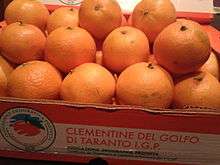Clementine del Golfo di Taranto
| Clementines of the Gulf of Taranto | |
|---|---|
 | |
| Species | Citrus × clementina |
| Cultivar group | Clementine cultivars |
| Origin | Southern Mediterranean 19th Century or less probably China |
| Cultivar group members |
|
The Clementine is a citrus hybrid between the willowleaf mandarine (Citrus x deliciosa) and a sweet orange (Citrus x sinensis).[1][2]
Origins
According to some sources, it was discovered for the first time in the garden of the orphanage of Brother Marie-Clément in the late 19th century in Misserghin, Algeria and so formally named in 1902.[3][4][5] Other sources have attributed a more ancient origin in China because of the similarity with some fruit native to the provinces of Guangxi and Guangdong even though these are mandarin hybrids.[6]
Fruit characteristics
The Clementines of the Gulf of Taranto PGI (Clementine del Golfo di Taranto IGP in Italian) are circular shaped with a wrinkled skin. They are usually orange and seedless but the 5% of fruit can contain a maximum of three seeds and the 30% of the skin's fruits can be green-coloured. The drip irrigation is practiced throughout the year paying attention to not to water the crown. The fruits are harvested by hand. They have a sweet flavour and an intense aroma.[7]
For 100 grams:
| Water | Protein | Fat | Carbohydrate | Fiber | Energy Value |
|---|---|---|---|---|---|
| 87,5 | 0,9 | 0,1 | 8,7 | 1,2 | 37 kcal[8] |
Geography
The western side of the Gulf of Taranto is located between the mountains of the Basilicata and the Ionian Sea and it is characterised by mild temperatures and a constant sea-breeze. The citrus plantations are spread among the villages of Massafra, Statte, Palagianello, Castellaneta, Ginosa and Palagiano where every year a Clementines Festival is held.
Curiosity and folklore
At Christmas, it is very common in Apulia to play a traditional version of the tombola. Especially when the children play it with relatives, it is typical to use some pieces of the peel of the clementines to cover the numbers that have been already announced.
Consortium
Consortium: Consorzio Agrumicoltori Tarantini, Palagiano (Taranto)
See also
References
- ↑ Shimizu, T.; et al. (2016). "Hybrid Origins of Citrus Varieties Inferred from DNA Marker Analysis of Nuclear and Organelle Genomes". PLOS ONE. 11 (11): e0166969. doi:10.1371/journal.pone.0166969. ISSN 1932-6203.
- ↑ Ga, W.; et al. (2014). ". "Sequencing of diverse mandarin, pummelo and orange genomes reveals complex history of admixture during citrus domestication"". Nature Biotechnology. 32: 656–662. doi:10.1038/nbt.2906. PMC 4113729.
- ↑ Trabut, L. (1926). "Les hybrides de Citrus nobilis : La Clémentine". Revue de botanique appliquée et d'agriculture coloniale. 6 (60): 484–489. doi:10.3406/jatba.1926.4435. ISSN 0370-3681.
- ↑ Bretó, M.P.; et al. (2001). "The Diversification of Citrus clementina Hort. ex Tan., a Vegetatively Propagated Crop Species". Molecular Phylogenetics and Evolution. 21 (2): 285–293. doi:10.1006/mpev.2001.1008. ISSN 1055-7903.
- ↑ Powell, L. J. (2009). "A Review of "Citrus: A History"". Food and Foodways. 17 (2): 136–138. doi:10.1080/07409710902925912. ISSN 0740-9710.
- ↑ Stanley, J. (2016). African Art: A Bibliographic Guide. Smithsonian Institution Libraries Research Guide. Smithsonian Institution Libraries.
- ↑ "Qualigeo.eu".
- ↑ Regione Puglia, Assessorato Risorse Agroalimentari (2006). Atlante dei prodotti tipici agroalimentari di Puglia. Modugno (Bari): Edit. p. 223.